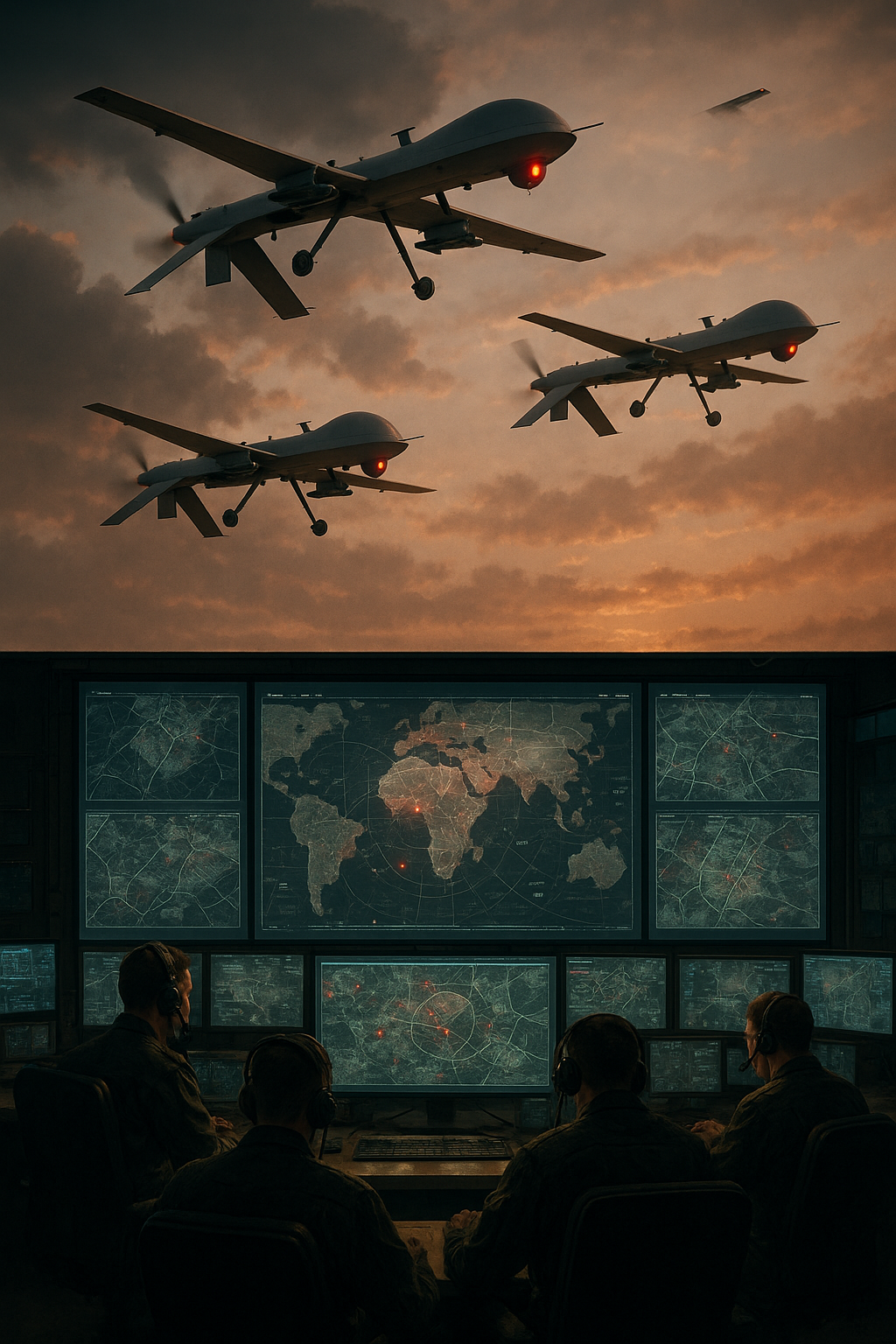⚔️ Wars in Times of Artificial Intelligence and Technology
Dear readers, it’s not that I like to attract or call negative things —I deeply believe in energy and the law of attraction—. However, these days I’ve been researching and reflecting on a topic I consider important to share: what would happen if a conflict broke out in current times?
I don’t propose this to live in fear, but to understand how technology and artificial intelligence would behave, and to be at least aware of what we could expect and how to react as much as possible.
The invisible battlefield
In 2025, the first line of a war is not always physical: it’s in the waves, in satellites and in data.
A swarm of drones watches the sky with thermal cameras and radar sensors. Their transmissions travel through satellite links to computing nodes that apply algorithms capable of classifying in milliseconds: are these enemy vehicles, civilians or simple electronic decoys?
The initial decision no longer passes only through a soldier with binoculars, but through software that crosses satellite images, thermal patterns and historical data. And like any system, it can make mistakes. An interpretation error can ignite the spark of escalation.
 Drones and mapping systems in modern warfare
—
Drones and mapping systems in modern warfare
—
Decisions in milliseconds
In command centers, the scene looks like something from a futuristic movie: walls covered with screens, dynamic 3D maps and real-time scenario simulations.
Technology crosses layers of information:
- AI to predict safe routes.
- Big data to identify movement patterns.
- Political impact models that anticipate social and diplomatic reactions.
A commander can see in seconds a recommendation like: “90% probability of success if attacking from the north flank”. The temptation to trust the machine is great, but not always the wisest.
The communications front
Communications are the backbone of any modern army. Constellations of low-orbit satellites, optical links and 5G antennas keep coordination alive even in remote areas.
But here comes electronic warfare: radars that locate signals, interference equipment capable of blocking transmissions, spoofing attacks that deceive a drone making it believe it should land somewhere else.
In many cases, losing electronic warfare equals losing the entire war. A disconnected army is a blind army.
Unrelenting cyber defense
While all this happens on land and in the air, another battle is fought in cyberspace.
Servers, firewalls and intrusion detection systems act as invisible trenches. Algorithms patrol military and civilian networks, looking for strange signals: a server that turns on in Moscow at midnight, irregular access in Washington, a drone that changes its flight pattern without explanation.
What’s disturbing is that the enemy also trains their models. Thus, we enter a cat and mouse game: AI against AI, hackers against defenders, satellites against interference.
Real cases that show the way
Although we speak of hypothetical scenarios, we have already seen how technology redefines conflicts:
Ukraine (2022–2025):
Drones became protagonists. Russia deployed electronic warfare systems to block GPS and communications, forcing Ukraine to innovate. Satellite networks, especially Starlink, became critical infrastructure, even being targets of cyber attacks.
 Drones in modern warfare: Ukraine conflict shows the reality of technological power concentration
Drones in modern warfare: Ukraine conflict shows the reality of technological power concentration
Middle East:
The Iron Dome defense system intercepts missiles in seconds thanks to algorithms that decide which ones represent a real threat and which ones can be let through. An example of how technological speed saves lives, but also shows dependence on automated decisions.
Who really has these capabilities?
Technological power in war is far from balanced. Only a few powers concentrate the most advanced capabilities: United States (military satellites, AI and smart weapons), China (drones and electronic warfare), Russia (interference and GPS), Israel (automated defense like Iron Dome) and NATO in Europe (cooperation in cyber defense and AI projects).
The difference is enormous: in 2025, the US has more than 5,000 satellites, China about 700, Russia about 200… and the rest of the world much less.
Meanwhile, regions like the EU depend on cooperation, and Latin American countries —like Chile— focus more on territorial security with imported technology than on developing high-tech offensive systems.
In summary: power is highly concentrated in few hands, and the gap with the rest of the world is growing.
Critical infrastructure under threat
What differentiates current conflicts is that armies are no longer the only targets. Banks, airports, ports and electrical networks can also be targets, because their interruption generates immediate economic and social chaos.
- A cyber attack on banks can block payments and leave the population without access to their money.
- Airport interference can paralyze flights and isolate entire cities.
- A cut in electrical networks affects hospitals, transportation and basic communications.
We must also consider that civilian cameras and services themselves —from urban CCTV to social networks or “smart city” systems— can become sources of information in a conflict. Analyzed with artificial intelligence, this data allows tracking movements, identifying concentrations of people or mapping critical infrastructure. This demonstrates that the border between civilian and military is increasingly diffuse, and that protecting the privacy and data of the population will be as important as safeguarding satellites or radars.
Here technological warfare intersects with daily life: the infrastructure we use every day can become a digital battlefield.
What to do in case of electronic warfare?
Electronic warfare doesn’t only affect armies: it can also hit daily life. Although we can’t control everything, there are ways to be more prepared:
- Keep key information offline: important documents and contacts written down physically.
- Have communication alternatives: radios, applications that work without internet or family agreements about meeting points.
- Prepare the basics: water, non-perishable food, batteries and portable chargers.
- Don’t depend only on GPS: a paper map can be more useful than an app if the signal fails.
- Stay calm and verify sources: disinformation can be as dangerous as lack of signal.
It’s not about living in fear, but about being aware that technological dependence is also a vulnerability.
Final reflection
Technology and artificial intelligence are already part of modern conflicts, and they will continue to be. Many of the tools we use daily —GPS, AI in our phones, satellite internet— are the same ones that can define a battlefield.
The challenge is not only technical, but human and ethical. As the UN warned in 2023, “lethal autonomous systems represent an unprecedented challenge for international humanitarian law and for State responsibility.”
The big question is not whether technology will be part of conflicts —because it already is—, but how far we are willing to let it decide for us.
📚 Recommended readings
The shifting battlefield: technology, tactics, and the risk of blurring lines in warfare (ICRC analysis)
Analysis by the International Committee of the Red Cross on how technology is transforming modern conflicts and the legal challenges this presents.
https://blogs.icrc.org/law-and-policy/2025/05/22/the-shifting-battlefield-technology-tactics-and-the-risk-of-blurring-lines-of-warfare/
AI-Driven Tactical Communications and Networking for Defense: A Survey and Emerging Trends (recent technical study on AI applied to defense networks and communications)
Recent technical study on AI applications in defense networks and communications systems.
https://arxiv.org/abs/2504.05071
Six ways AI could cause the next big war, and why it probably won’t (recent speculative reflection on AI risks)
Recent speculative reflection on the risks of AI in potential conflicts and why they might not materialize.
https://thebulletin.org/premium/2025/07/six-ways-ai-could-cause-the-next-big-war-and-why-it-probably-wont/
✍️ Claudio from ViaMind
Dare to imagine, create and transform.
